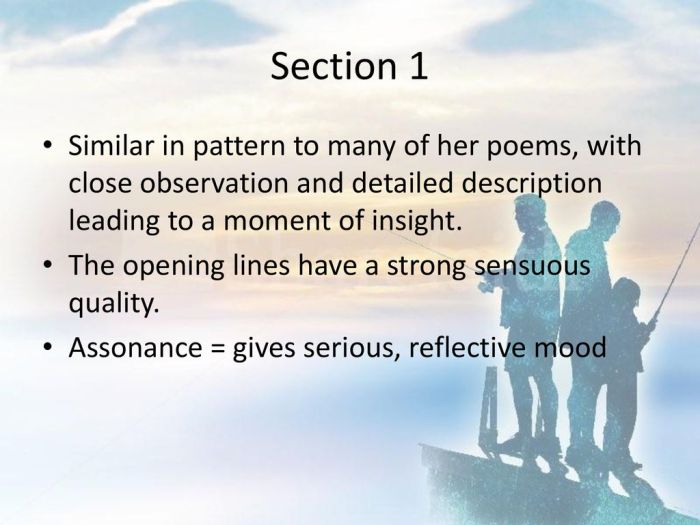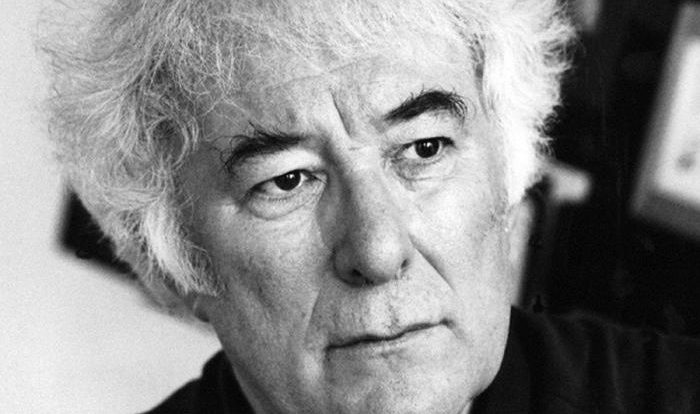Elizabeth bishop at the fishhouses – Elizabeth Bishop’s “At the Fishhouses” delves into profound themes of isolation, mortality, and the human condition, capturing the essence of humanity’s relationship with nature through vivid imagery and introspective language.
The poem’s evocative descriptions and symbolic undertones invite readers to contemplate the complexities of life, loss, and the enduring power of memory.
Literary Elements

In Elizabeth Bishop’s poem “At the Fishhouses,” imagery plays a vital role in conveying the poem’s themes and atmosphere. The vivid descriptions of the fishhouses, the fishermen, and the sea create a sense of place that is both evocative and unsettling.
Imagery
- The poem opens with a striking image of the fishhouses: “The fishhouses are black, their windows boarded.”
- The fishermen are described as “heavy men” with “lined faces,” suggesting their hard work and exposure to the elements.
- The sea is depicted as both beautiful and dangerous, with its “blue mussel shells” and “cold sea-wind.”
Symbolism
The fishhouses themselves are symbols of the human condition. They are places of work and commerce, but they are also places of isolation and death. The fishermen represent the struggle for survival, while the sea represents the vastness and indifference of nature.
Structure
The poem’s structure is deliberately fragmented and disjointed, reflecting the speaker’s fragmented state of mind. The poem moves from one image to the next, with no clear narrative or logical progression. This structure creates a sense of unease and uncertainty, which mirrors the speaker’s own feelings of alienation and loss.
Themes
Elizabeth Bishop’s “At the Fishhouses” explores a number of complex themes, including isolation, mortality, and the human condition.
Isolation
The poem’s speaker feels isolated from the world around them. They are alienated from the fishermen, the sea, and even from their own thoughts. This isolation is both physical and psychological, and it is a source of great pain for the speaker.
Mortality
The poem also explores the theme of mortality. The fishhouses are a reminder of the transience of life, and the fishermen are constantly confronted with the possibility of death. The speaker’s own mortality is also a source of anxiety, and they are haunted by the thought of their own death.
The Human Condition
“At the Fishhouses” is ultimately a poem about the human condition. It explores the challenges and struggles that we all face, and it offers a glimpse of the beauty and wonder that can be found in the midst of suffering.
Context: Elizabeth Bishop At The Fishhouses
Elizabeth Bishop (1911-1979) was an American poet who is considered one of the most important poets of the 20th century. She was born in Worcester, Massachusetts, and she spent much of her life traveling the world. Her poetry is often characterized by its precision and clarity, as well as its exploration of themes of loss, isolation, and the natural world.
Historical and Cultural Context
“At the Fishhouses” was written in 1955, during a time of great social and political change in the United States. The Cold War was in full swing, and the civil rights movement was gaining momentum. The poem reflects the anxiety and uncertainty of the times, as well as the growing sense of alienation and isolation that many people felt.
Personal Experiences and Observations
Bishop’s own personal experiences and observations also influenced the poem. She had spent time in Nova Scotia, where she observed the fishermen and fishhouses that she describes in the poem. She was also deeply affected by the death of her mother, which occurred shortly before she wrote the poem.
Style and Language

Elizabeth Bishop’s “At the Fishhouses” is written in a clear and concise style. The poem’s language is precise and evocative, and Bishop uses a variety of literary devices, such as imagery, symbolism, and metaphor, to create a vivid and memorable impression.
Figurative Language
- The poem is filled with vivid imagery, such as “the fishhouses are black, their windows boarded” and “the cold sea-wind / picking the bare bones of the shore.”
- Bishop also uses symbolism throughout the poem. The fishhouses, for example, can be seen as symbols of the human condition, while the sea can be seen as a symbol of the vastness and indifference of nature.
- Bishop also uses metaphor in the poem, such as when she compares the fishermen to “heavy men” and the sea to a “blue mussel shell.”
Impact of Language
Bishop’s use of language creates a poem that is both beautiful and haunting. The poem’s precise and evocative language creates a vivid and memorable impression, while its use of figurative language adds depth and complexity to the poem’s themes.
Critical Reception
Elizabeth Bishop’s “At the Fishhouses” has received critical acclaim since its publication in 1955. The poem has been praised for its precision and clarity, as well as its exploration of themes of loss, isolation, and the natural world.
Positive Reviews, Elizabeth bishop at the fishhouses
- In a review of the poem, critic Randall Jarrell wrote, “At the Fishhouses” is “one of the most beautiful poems I have ever read.”
- Critic Helen Vendler has called the poem “a masterpiece of American poetry.”
Negative Reviews
While most critics have praised “At the Fishhouses,” there have been some negative reviews. Some critics have found the poem to be too bleak and depressing, while others have found it to be too fragmented and disjointed.
Enduring Legacy
Despite the occasional negative review, “At the Fishhouses” remains one of the most important and influential poems of the 20th century. The poem has been studied by scholars and taught in schools for decades, and it continues to be a source of inspiration for poets and readers alike.
Question Bank
What is the central theme of “At the Fishhouses”?
The poem explores the interconnected themes of isolation, mortality, and the human condition, delving into the complexities of life, loss, and memory.
How does Bishop use imagery in the poem?
Bishop employs vivid and evocative imagery to create a sensory experience for the reader, capturing the sights, sounds, and smells of the fishhouses, the surrounding landscape, and the people who inhabit it.
What is the significance of the symbolism in “At the Fishhouses”?
The poem is rich in symbolism, with the fishhouses representing the transience of life, the sea symbolizing the vastness and mystery of existence, and the herring gulls embodying the resilience and adaptability of nature.

